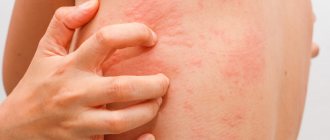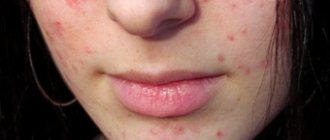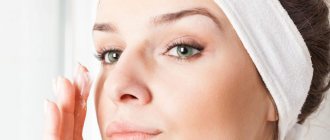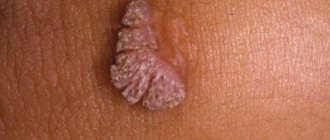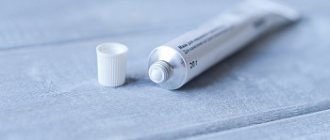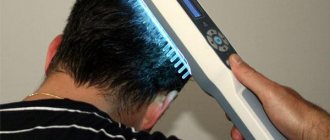When a person experiences itching or itching in any part of the body, coping with the phenomenon is quite simple. It is enough to scratch the problem area and the itching will subside. But if the skin itches in a hard-to-reach place, and even constantly, this can become a real problem. Especially when your back itches. Why itching in the back may occur and how to cope with it is the most important and useful information.
Why does my back itch?
Senile itch
Age-related changes affect all human organs, including the skin.
In older people, the skin becomes thinner, dries out, and becomes sensitive to allergens and mechanical irritants. These factors, as well as various diseases of internal organs and systems, cause the so-called senile itch - an unpleasant sensation that can be constant or occur periodically. Senile, or senile, itching can cover the entire body or only certain areas. The pathological condition is accompanied by peeling of the skin. Most often, unpleasant sensations occur in the evening and at night.
Pathophysiology
Signals for pain and itching caused by skin causes are transmitted along the same pathways, but the afferent C-fibers differ functionally: one part of the nerve fibers is stimulated by histamine, the other by other substances that cause itching (for example, serotonin). There is evidence of similarities between neuropathic pain, itch and cough. Their common property is peripheral and central sensitization of the afferent nervous system. This explains the effectiveness of antiepileptic drugs and antidepressants for such a variety of conditions, as well as the ineffectiveness or low effectiveness of H1 blockers for some types of itch.
Mechanisms and mediators involved in the formation of the sensation of itching:
- amines (histamine, serotonin, acetylcholine);
- proteases and kinins (tryptase, chymase, kallikrein, bradykini, etc.);
- neuropeptides (substance P, neurotensin, etc.);
- cytokines (prostaglandin E reduces the threshold for susceptibility to itching);
- opioid receptors (metenkephalin, leuenkephalin, β-endorphin), naloxone reduces itching, opiates relieve pain but increase itching.
Causes of senile itching
The main reason for the condition is natural aging of the body. As a person ages, the synthesis of hormones “responsible” for the elasticity of the skin decreases. Metabolism slows down, resulting in slower tissue regeneration. The skin becomes dry and wrinkled.
Several contributing factors increase the likelihood of aging itch. These include:
- gastrointestinal diseases;
- diabetes;
- renal failure;
- liver diseases;
- atherosclerosis;
- atrophy of the skin glands;
- cognitive disorders;
- violations of water-salt metabolism;
- dehydration.
Often, an unpleasant sensation can appear due to changes in air temperature, wearing synthetic clothing, swimming in too hard water or using products with an inappropriate pH level.
Useful tips
Systemic treatment is often not necessary if the skin condition improves.
If your skin becomes dry, stop using soap; bathing in warm rather than hot water, lubricating the skin after bathing and at night, applying a damp cloth for 15–20 minutes, then applying cream or ointment.
For damp skin - protective cream (zinc paste), drying dressings with Burov's liquid (aluminum acetate 8%, diluted 1:10–1:20).
Local anti-itch remedies
Zinc oxide has anti-inflammatory, antiseptic and antipruritic effects, and is used in concentrations of 10–50% in creams, liniments, lotions, ointments and pastes that are effective in the treatment of localized forms of itching.
Menthol, when applied to the skin and mucous membranes, dilates blood vessels, causing a feeling of coldness and then numbness, significantly reducing itching. It is used in powders, ointments, and lotions in concentrations of 1–10%.
Camphor , when applied to the skin, produces a warm sensation followed by mild anesthesia, which reduces itching. It is used in the form of liniments, lotions and ointments in concentrations of 2–20%.
Important
It should be remembered that products with menthol and camphor cannot be used simultaneously on one area of the skin.
Calamine , a lotion containing zinc carbonate (calamine), zinc oxide and a small amount of phenol, is widely used in the treatment of itching and atopic dermatitis.
Symptoms of pathology
Characteristic signs help identify senile body itching:
- thinning and drying of the skin (skin becomes papery);
- the appearance of red spots, rashes, pustules on the body;
- absence of scratches and wounds in areas of the body that are prone to itching;
- itching worsens in the evening and at night;
- The duration of discomfort can range from several days to several months.
Sometimes patients may itch different parts of their body every day.
Nutrition and diet for age-related itching
You should exclude fatty, spicy, fried foods, pickles and marinades, and smoked foods from your diet. You should use caution (or better yet, avoid) coffee, chocolate, and other cocoa derivatives. Nutrition should be complete and varied, the body should receive a sufficient amount of dietary fiber.
Depending on the intensification and easing of itching, the diet should be constantly adjusted. If after eating citrus fruits, for example, the itching intensifies, then it is better to exclude citrus fruits.
Diagnostics
With a similar problem, patients come to see a dermatologist. As a rule, the diagnosis is made based on a survey and examination.
For a more accurate diagnosis, the dermatoscopy method is used - studying the biomaterial using magnifying lenses.
In some cases, it is appropriate to conduct additional examination:
- take blood, urine and stool tests;
- test for allergens.
If the cause of the pathology is a disease of the internal organs, the patient is referred to a therapist or other specialized specialist who will supervise the underlying disease.
Patient management
General events
- If your skin is dry, use soap substitutes with a moisturizing effect instead of soap, and apply moisturizing cream to your skin 2-3 times a day.
- Review the list of medications you are taking: if a possible cause of itching is a medication, it needs to be changed.
- For atopic/contact dermatitis: topical corticosteroids once a day for 2-3 days if there is inflammation but no infection.
- For scabies: topical permethrin or malathion.
- For cholestatic itching due to obstruction of the common bile duct: duct stenting – if possible.
Nonspecific treatment
It is carried out taking into account the condition of the skin - different approaches to local treatment on intact and macerated skin.
Antipruritic agents for topical use : 0.5−2% cream with levomenthol (menthol) is effective on intact skin if the itching is localized or more intense in a certain area.
Sedating antihistamines can be prescribed 1 hour before bedtime; if the effect does not persist for a day, two-time use is possible:
- Hydroxyzine/Atarax, Vistaril 25 mg orally at night;
- promethazine/Pipolfen 25 mg orally at night;
- diphenhydramine/Diphenhydramine 50 mg orally 1–2 times a day;
- Dimetindene/Fenistil 1 mg orally daily plus Fenistil gel (0.1% dimethindene) topically 3 times a day will help in most difficult cases.
Some non-sedating antihistamines may have an antipruritic effect (eg, loratadine/Claritin, cetirizine/Zodac, Zyrtec).
Antihistamines for external use (for example, Fenistil cream) on intact skin are used for no longer than a few days in cases where itching is caused by the release of histamine (for example, acute drug rash).
TCAs with antihistamine properties : doxepin/Doxepin in a dose of 10-75 mg orally at night. Antidepressants will help in cases where anxiety or depression occurs.
Specific treatment
Table 1 and Appendix 1 present the principles and regimens of drug therapy for itching of various etiologies.
How to treat?
The goal of therapy for senile skin itching is to relieve symptoms. Several techniques are used to alleviate the condition. The choice of treatment regimen depends on the cause that provoked the pathology and the nature of the manifestations.
Preparations for senile itching
The following types of drugs are used to treat senile itching:
- antihistamines (Diazolin, Diphenhydramine, Suprastin);
- neuroleptics (Promazine, Clozapine);
- immunostimulants (Cycloferon, Echinacea tincture);
- corticosteroids (Betazon, Betaderm, Kremgen);
- vitamin complexes;
- alcohol tinctures;
- pharmaceutical ointments and creams with a soothing and cooling effect (Fenistil, Clotrimazole, Menovazan, etc.).
Corticosteroid drugs are taken only as prescribed and under the supervision of the attending physician. In general, hormone therapy is used for patients with autoimmune diseases, with the doctor carefully weighing the benefits and risks of treatment for each patient.
If the cause of itching is stress and other cognitive conditions, the patient is prescribed mild sedatives: valerian infusion, Novopassit, etc.
You can quickly stop an attack with warm water. The itchy area is showered with water for a few minutes. Before water procedures, you can apply 2-3 drops of peach tree essential oil to the skin.
Body hygiene
When symptoms of senile itching appear, it is important to pay attention to hygiene. For bathing, you need to use soft products with a neutral pH, and if possible, wash with water that is not too hard.
When bathing, do not use hard washcloths or scrubs.
The patient's underwear and bedding should be made from natural fabrics.
Senile body itch and diet
If you have senile itching, you should exclude the following foods from your diet:
- grilled meat;
- marinades;
- baked goods;
- citrus;
- coffee;
- spices;
- alcoholic drinks.
The diet includes seafood, herbs, fresh vegetables, pumpkin seeds, nuts, and unrefined oils.
Folk remedies
Some types of senile itching can be successfully treated with folk remedies.
Traditional methods of treatment:
- herbal baths;
- applying vegetable oil to flaky areas;
- using homemade ointment made from aloe and Vaseline.
Before using unconventional recipes, you should consult your doctor.
Other techniques
For patients who experience itchy skin as a response to stress, it is very important to control their emotions. In such cases, it is useful to do yoga, auto-training, and use various relaxation techniques.
Treatment process
Relief from the symptoms of itchy back varies at different ages. The products that the doctor will prescribe that can relieve itching largely depend on the condition of the skin.
Therapy for older patients
For people who have not reached old age, the therapy will be as follows.
It all starts with constant hygiene and proper care. The skin, gently cleansed, can be treated with a 5% vinegar solution or talc powder.
Antihistamines
If necessary, antihistamines can be prescribed:
- Tavegil;
- Erius;
- Zyrtec;
- Loratadine;
- Suprastin.
Antiallergic drug Tavegil
Sedatives
Sedatives may be prescribed:
- valerian;
- peony tincture;
- motherwort in tincture;
- Novo-Passit.
Peony tincture
Physiotherapeutic manipulations
Physiotherapeutic manipulations, which include:
- transcutaneous stimulation of nerve endings;
- phototherapy;
- laser therapy;
- magnetic therapy;
- acupuncture;
- diadynamics.
ethnoscience
It is possible to turn to traditional medicine, especially if the itching of the back is caused by skin sensitivity, inflammation and irritability. Here, baths with decoctions are invaluable. They are made by pouring about two liters of decoction of the following plants into the bathtub:
- chamomile;
- juniper;
- coltsfoot;
- cornflower;
- plantain;
- yarrow;
- violets;
- calendula;
- walnut leaves;
- oak bark.
Baths with decoctions are excellent helpers in the fight against itchy skin.
The standard recipe for preparing a decoction is a tablespoon of crushed parts of the plant per one hundred milliliters of water, boil for 5 to 10 minutes.
Therapy for older patients
In old age, drugs that suppress the sensation of itching locally and drugs for oral administration are prescribed as local treatment.
Local tools
Ointments containing a corticosteroid base. The method is good for chronic inflammation of the altered epithelium.
- Berlicourt;
- Sinaflan;
- Hydrocortisone.
Sinaflan ointment
A moisture-preserving alcoholic tincture of mint is also used. Compresses from it are also used to stimulate blood circulation, wrapping in the form of applications with gauze soaked in tincture, itchy areas or lubricating the affected areas. The application lasts for half an hour. You can lubricate at night or as itching occurs until the condition is relieved.
Capsaicin ointment is often prescribed, which relieves neuropathic itching. But you need to be careful with the drug, due to the presence of multiple side effects.
To relieve chronic itching, immunomodulators are used:
- Calcineurin;
- Tacrolimus;
- Pimecrolimus.
The drug Tacrolimus
Among analgesics, Pramoxine is used locally, a blocker of nerve endings to cause loss of sensitivity.
Salicylic acid may be prescribed to areas of severe itching.
Preparations for oral administration
Both to maintain the condition in addition to local therapy, and in case of its ineffectiveness, oral medications are used.
- Antihistamines that will relieve itching due to an allergic reaction: Loratadine, Chloropyramine, Suprastin.
- Antidepressants - reduce the manifestations of mental deterioration: Fluoxetine, Sertraline, Citalopram.
- Neuroleptics - help against neuropathic itching: Chlorpromazine, Aminazine, Tiapride. Prescribed with caution.
The drug Aminazine in tablet form
Itchy skin in the back is a serious complex problem at any age. It is important to find out the reasons for the appearance as early as possible in order to prevent a deterioration in a person’s general health and quality of life. In many cases, diagnosing the causes of itching helps to cure serious diseases, the symptom of the initial stage of which may be this phenomenon.
Video - Why do people itch?
Popular questions about senile itch
Can it develop in young people?
Young people may also suffer from itchy skin, but the term “senile itch” is not applied to them.
Where is itching most often located?
The localization of pathology is individual. The patient may itch the whole body or individual areas, and it may be different every day.
Which doctor treats senile itch?
If unpleasant symptoms appear, you should consult a dermatologist. If the patient has a history of chronic diseases, you should also visit a specialized specialist.
How to prevent itchy skin?
The following measures may help prevent itching:
- Wear loose cotton clothing.
- Use a humidifier to keep your environment moist and prevent dry, itchy skin.
- Keep your nails trimmed.
- Shower daily.
- Keep your stress levels under control.
- Limit or avoid caffeine and alcohol.
- Drink plenty of water
- Keep your skin hydrated - use a good moisturizer.
- Check for allergic reactions to certain foods such as milk, eggs, peanuts, fish, mushrooms, etc.
- Replace potentially chemically harmful household products such as: laundry detergent/softener, dryer sheets, shampoo, soap, lotion with more natural and fragrance-free products.
In some cases, the itching can become intense and last a long time. If you notice any of the following symptoms, you should contact your dermatologist immediately.
